Laura Knight-Jadczyk
sott.net
Tue, 12 Feb 2008 13:39 EST
 |
| ©Peter Grego |
| Impression of the 1178 lunar event |
Last time I said I was going to talk about how much your "glorious
leaders" really hate and despise you and how they are plotting your
deaths while most of you are so screwed up that you not only do not see
this, you actually dance blithely toward disaster for yourselves and
your children. Well, I'm going to get there, but first, I want to tie
up a few loose ends and reiterate a couple of points.
As I mentioned in my previous article on this topic, the Discovery Channel special Super Comet - After the Impact,
places the comet that wiped out the dinosaurs in a modern setting,
using the same type of cometary body assumed to have caused the
extinction of the dinosaurs, the same size, same impact location, and
utilized all the computer modeling they have done on this past event to
try to show what might happen (and to show what they think happened
then).
Studies of the history of the Earth via various scientific methods
show us that there are relatively long periods of "evolution"
punctuated by rapid, overwhelming changes we call catastrophes. Many
scientists have noted the periodicity of these punctuational events.
What no one seems to know for sure is the mechanism that induces these
definitely periodic catastrophes.
It is suggested that the periodicity of these events relates to
galactic cycles and there is good evidence for this view presented by
Victor Clube in his book The Cosmic Winter. (You can really forget the nonsense going around about "Planet Nibiru" and "Project Camelot").
He suggests that galactic tides induct giant comets into our Solar
system and it is their disintegration products which interact strongly
and directly with the Earth with variable results at different (and
very frequent!) periods which results in the variations in the
geological record. Clube demonstrates that the breaking up of a giant
comet produces a wide range of debris from objects 10 km across, to
hundreds or thousands of 1 km sized bodies, to multiple swarms of
sub-kilometer sized bodies. Many of these bodies have sooty, black
surfaces making them almost impossible to see and many of them are in
an orbit very similar to the Taurid meteor streams, though a few may be
in an orbit rotated about 90 degrees. Clube posits that many (if not
most or all) of the asteroids in the Solar system split from a giant
comet (or many of them) thousands or tens of thousands of years ago,
and it is the streams of debris that pose the most serious and
immediate threats to our planet.
For example, one of the large asteroids in an Earth-crossing orbit
is named Hephaistos. It is about 10 km in diameter, about the same size
as the asteroid that is depicted as striking the earth in the
above-mentioned movie (the dinosaur extinction model). It is true that
the effects of the impact of such a body would be felt globally, but it
is not so clear that it would be exactly as "global" as depicted in the
movie.
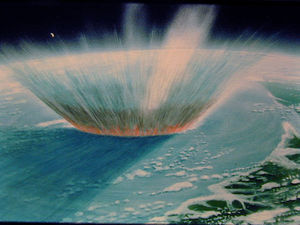 |
| ©William Hartmann |
| A painting showing how the alleged KT Impactor may have appeared. |
Nevertheless, the connection between a single impactor and past mass
extinctions has been made and popularized widely, and this may be
unfortunate considering the issues of more frequent and less "global"
events that Clube addresses.
The problem is, as Clube points out, a solitary large impact is,
from an astronomical point of view, quite unlikely to be the only
agency at work in such extinctions. Further, when one considers the
details of the evidence, both astronomical and geological, many
discrepancies in the single impactor scenario begin to emerge.
When the Alvarezes, pere et fils, came across the iridium
layer at the K-T extinction boundary, announcing that iridium in those
amounts could only be thrown up by the impact of a large meteorite,
this shocking idea was taken up gleefully by the press and everyone was
on the hunt for iridium.
Clube points out that there are several problems with the "single
impact" interpretation of the presence of iridium at the extinction
boundary. The first problem is that the concentration of the element is too high.
Why? Well, because if it were a single, giant impactor, such an
asteroid would excavate several hundred times its own volume of Earth
crust material and blow it into the atmosphere mixed with its own
material. This means that the iridium would be significantly diluted
and would not precipitate on the planet in such concentrations as have
been found. However, at many of the sites examined, it is noted that
the iridium has been diluted by only 20 times its own volume (keeping
in mind that the iridium in the comet/asteroid is already only a
percentage of the total volume of the extraterrestrial body!)
Additionally, other chemicals associated with the alleged single
impact event do not fit the stony meteorite theory very well. There is
an abundance of rare elements such as osmium and rhemium; enormous and
overabundant common elements such as antimony and arsenic. In respect
of this finding, Clube points out that, after a January 1983 eruption
of Kilauea, particles collected from the volcano were found to have
high concentrations of arsenic, selenium and other elements found in
high abundance at the extinction boundary. These volcanic particles
were also found to be very rich in iridium. Clube suggests that the
iridium anomaly may, therefore, be a big red herring. He notes: "...it
is interesting to speculate whether, had a volcanic source of iridium
been known in 1980, a meteorite impact would have been suggested" by
the Alvarezes?
Probably not.
So, that was probably a good thing because it at least drew press
attention to the matter since Clube also points out that there is an
impressive amount of evidence that the extinction event was not just a
process of evolutionary change and decay. Catastrophic changes - a
profound ecological shock - took place across the Cretaceous-Tertiary
boundary, and the devastation was certainly sudden. So the Alvarez
theory opened the door to consider that in a world that was tightly
bound up in Uniformitarianism.
Among the interesting finds at this level of Earth's history is that
very large amounts of soot are also present at the extinction boundary.
The conclusion is, of course, that global wildfires were raging during
the extinction event. The movie tried to depict that with computer
models (made on the assumption of a single large asteroid impact) which
had the entire atmosphere of the earth heating up to the point where
things just ignited spontaneously. That may not be exactly how things
happen even with a very large meteor impact.
Another point that Clube makes is that there is not a trace of
meteoritic debris in the form of stony inclusions in the sediments.
I won't go into all the details; suffice it to say that it begins to
look like the stray impact of a single 10 km wide asteroid is not the
cause of the global extinction after all.
What is a realistic scenario?
Clube presents the evidence that this extinction event was an
episode of bombardment of many, dozens, hundreds, thousands of cometary
fragment and/or meteorite type bodies, some of them large, liberating
copious amounts of meteorite dust in the Terran atmosphere, many of
them exploding overhead in rains of fire. These swarms would be
"swimming" in streams of comet dust - tons of it - which would also be
loading the atmosphere and precipitating onto the earth over months and
years. The high concentrations of iridium found at the dinosaur
extinction boundary at several localities, and the absence of bulk
meteoritic debris, are hard to explain in terms of a single big bang
but easily understood in terms of zodiacal dust as a provider of the
input. Added to this, there is increasing evidence for a multiplicity
of impacts at the dinosaur extinction boundary, as well as at other
points of global catastrophe such as the Permian - Triassic (P - Tr) extinction event.
The swarm theory also easily accounts for the huge amounts of soot at
the boundary. An Earth ablaze is within the capacity of an
exceptionally intense swarm to produce, but probably beyond that of
even a 10km wide single impactor. In short, the extinction of the
dinosaurs may very well have been a complex, traumatic, and prolonged
affair.
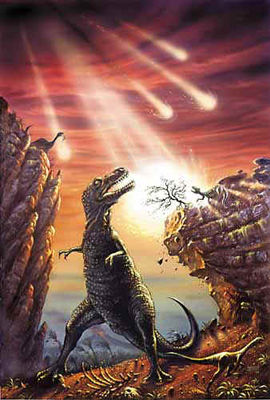 |
| ©Unknown |
| What the dinosaurs saw? |
Clube proposes that the Earth itself is a storehouse of information
about its interactions with the Galaxy, and that it is the Galaxy
itself, and Earth's position in it, that drives the cycles of
extinctions mainly because the cycles of events best fit known galactic
cycles.
The one thing that stands out from all of the evidence is the
importance of very large comets that enter the Solar System and break
apart, leaving streams of debris that interact with our planet for
millennia after the parent body or bodies have been captured and torn
apart by intra-solar system forces. That such bombardments of the earth
have occurred at other times is becoming more widely known, witness the
work of Richard Firestone, Alan West and Simon Warwick-Smith who have
identified the Carolina Bays as "air impact" craters from overhead
cometary explosions exactly like that of Tunguska. In fact, similar
"craters" were found in the Tunguska region with the exact same
morphology. This even has been dated to about 12,500 years ago and was
global in extent and cataclysmic in effect. Life on Earth almost came
to an end. What is frightening about this even is the sheer numbers of
craters - upwards of 50,000 of them.
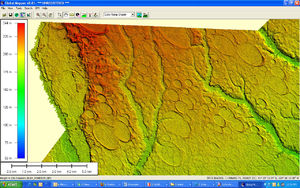 |
| ©Unknown |
| This image shows numerous craters in Robeson County, North Carolina |
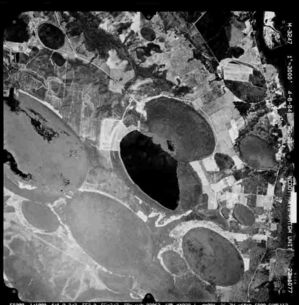 |
| ©Unknown |
| Arial photo the Carolina Bays craters |
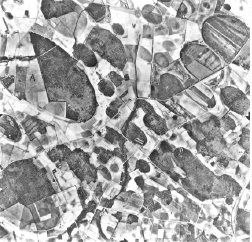 |
| ©Unknown |
| The largest crater in this particular image is approximately 1.4 miles across |
Companion Star?
Clube mentions the companion star hypothesis briefly, noting that
"Certainly the companion-star hypothesis adopts the central mechanism
of the galactic one, namely the creation of comet showers through
regular comet cloud disturbances." He then dismisses this as facing
"insuperable problems." The "insuperable problems" are the proposed
orbital periods for the hypothesized companion star and his idea that
there would be far more cratering if the motive mechanism was a
companion star. He may be entirely correct and his theory of galactic
tides and comet birth in the cold, dark reaches of space certainly
deals with the main elements of what we know about our celestial
environment. As he notes:
The astronomical framework, grounded in celestial observations, is
the basis for the theory of terrestrial catastrophism described here.
... It is in our view essential , if one is to arrive at a true
picture, to take account of all the relevant evidence: "hard evidence"
in the geologist's sense has to be coupled with some respect for hard
astronomical facts as well. Put another way, we do not need a 1 - km
asteroid to land in our presence to demonstrate the amount of kinetic
energy it will release. In particular, the correct picture must explain
recent as well as past events in the terrestrial record. Thus the giant
comet, and indeed the historical record, are essential elements in the
quest for overall truth. It is this inextricable linkage between the
very recent and the very remote past which lends urgency to the study:
if we get the grand picture wrong, the next set of old bones in the
ground could be ours.
We have presented some good evidence in this series of articles that
Clube's ideas are very likely correct or darn close: the earth has been
repeatedly and regularly showered with extraterrestrial debris of some
sort, and these showers have been generally disastrous from local
scales, to regional, national, and even continental. It seems clear
from the evidence that history itself is not a process of evolution,
but more often, devolutionary as each cosmic crisis has either resulted
in "survival of the lucky," as opposed to the fittest, and the more
recent ones have been amplified or utilized by ruling elites to pursue
their own agendas. On other occasions, the Earth has suffered insults
that have hardly turned a head in the human population. Tunguska was
one such event.
Tunguska
Just after 7:15 a.m. local time on 30 June 1908, in the central
Siberian plateau, there took place an impact of ferocious intensity.
Yet so isolated and vast is this region (half as large again as the
USA), it was almost twenty years before the Western world became aware
of the event.
©Unknown
How the Tunguska object may have appeared.
On the night of 30 June and 1 July, the sky throughout Europe was
strangely bright. Throughout the United Kingdom, over 3000 miles from
the point of impact, it was possible to play cricket and read
newspapers by the glow from the night sky. From Belgium came
descriptions of a huge red glow over the horizon, after sunset, as if a
great fire was raging. This strangely bright sky was seen throughout
Europe, European Russia, Western Siberia and as far south as the
Caucasus mountains. Photographs were taken at midnight or later, with
exposures of about a minute, in Sweden, in Scotland, and as far east as
the university city of Kazan, on the banks of the river Volga....Much comment was excited in newspapers and learned journals at the
time. Some thought that icy particles had somehow formed high in the
atmosphere and were reflecting sunlight. Others considered that a
strange auroral disturbance was involved. The Danish astronomer Kohl
drew attention to the fact that several very large meteors had recently been observed
over Denmark and thought that comet dust in the high atmosphere might
account for the phenomenon. But there was no agreement as to what had
happened.Over 500 miles to the south of the fall, a seismograph in the city
of Irkutsk near Lake Baikal, close to the Mongolian border, registered
strong earth tremors.Nearly 400 miles south-west of the explosion, at 7:17 a.m. on 30
June, a train driver on the Trans-Siberian express had to halt the
train for fear of derailment due to the tremors and commotion.Fierce gusts of wind were felt in towns 300 to 400 miles away.
In an Irkutsk newspaper dated 2 July it was reported that, in a
village more than 200 miles from the Tunguska river, peasants had seen
a fireball brighter than the sun approach the ground, followed by a
huge cloud of black smoke, a forked tongue of flame and a loud crash as
if from gunfire."All the villagers ran into the street in panic. The old women wept and everyone thought the end of the world was approaching."
[...]Local Siberian newspapers carried stories of a fireball in the sky,
and a fearful explosion, but by the autumn of 1908 these stories had
died out, and they went unnoticed in St. Petersburg, Moscow and the
west. The region was arguably one of the most inaccessible places on
Earth, in the centre of Siberia. ... However, rumours of an
extraordinary event persisted, transmitted back by geologists and other
intrepid researchers working in the area. These attracted the attention
of a meteorite researcher, Leonard Kulik,... It was not until 1927 that
an expedition ... led by Kulik, finally penetrated to the site of the
1908 explosion.
[...]The energy of the explosion has been calculated from the extent of
the flattened forest and from the small pressure waves which arrived at
the speed of sound and were recorded on barographs around the world.
... The wave trains were unlike any others which had been recorded up
until that time but resemble those obtained from a hydrogen bomb
explosion. It seems that the impact had an energy of 30 to 40 megatons,
about that from a few dozen ordinary hydrogen bombs....The date of fall (30 June) corresponds to the passage of the Earth through the maximum of the Beta Taurid stream. From this and its trajectory, it appears that the Tunguska object was part of the Taurid complex. Probably the Earth passed through a swarm within the stream.
©Unknown
Aftermath of the Tunguska explosion
©Unknown
Aftermath of the Tunguska explosion
©Unknown
This image shows the directions of the blast
©Unknown
This diagram shows the area of damage in Tunguska as compared to the size of Washington D.C.
The occurrence, this century, of an impact with the energy of a
hydrogen bomb does give cause for some concern, and it is interesting
to speculate on whether one's historical perceptions would be quite the
same had the bolide struck an urban area or a city. As it happens,
however, the Tunguska impact is fairly trivial:In this year, on the Sunday before the Feast of St. John the
Baptist, after sunset when the moon had first become visible a
marvelous phenomenon was witnessed by some five or more men who were
sitting there facing the moon. Now there was a bright new moon, and as
usual in that phase its horns were tileted toward the east; and
suddenly the upper horn split in two. From the midpoint of the divisin
a flaming torch sprang up, spewing out, over a considerable distance,
fire, hot coals, and sparks. Meanwhile the body of the moon which was
below writhed, as it were, in anxiety, and, to put it in the words of
those who reported it to me and saw it with their own eyes, the moon
throbbed like a wounded snake. Afterwards it resumed its proper state.
This phenomenon was repeated a dozen times or more, the flame assuming
various twisting shapes at random and then returning to normal. Then
after these transformations the moon from horn to horn, that is along
its whole lengthe, took on a blackish appearance. The present writer
was given this report by men who saw it with their own eyes, and are
prepared to stake ther honour on an oath that they have made no
addition or falsification in the above narrative.This curious report is written in the chronicles of the medieval monk known as Gervase of Canterbury. The year of the event was AD 1178 and the date, 18 June on the Julian calendar, converts to the evening of 25 June
on the modern Gregorian one. If real, it is clear that some
extraordinary event on the Moon is being described and the meteorite
expert Hartung proposed that what was observed and recorded 800 years
ago was the impact of a body on the Moon. The flame, he suggested, was
the writhing of incandescent gases, or sunlight reflection from dust
thrown out of the crater. The blackish appearance of the Moon along its
whole length was a temporary suspension of dust buoyed up by a
transient atmosphere. [...]Hartung deduced that if there was a crater, it would be at least 7
miles in diameter, possess bright rays extending from it for at least
seventy miles, and would lie between 30 and 60 degrees north, 75 and
105 degrees east on the Moon. ...As it happens, there is one crater with the predicted characteristics exists, a crater named after the seventeenth-century heretic Giordano Bruno.
This crater is located at 36 degrees N and 105 degrees E, within the
predicted area. It is 13 miles in diameter and is distinguished by its
remarkable brightness, and by the brilliant system of rays which extend
several hundred miles out from it. [...]
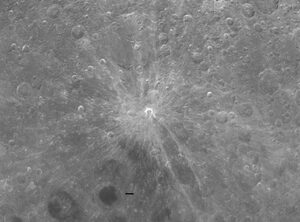 |
| ©Unknown |
| Giordano Bruno crater on the Moon has a diameter more of more than 13.6 miles or 22 kilometers |
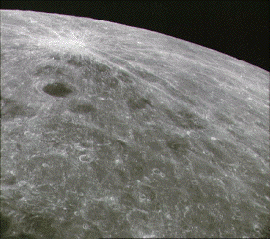 |
| ©Unknown |
| Giordano Bruno crater on the Moon |
It should be noted that NASA has attempted to debunk Hartung's theory, saying:
Such an impact would have triggered a blizzard-like, week-long
meteor storm on Earth -- yet there are no accounts of such a storm in
any known historical record, including the European, Chinese, Arabic,
Japanese and Korean astronomical archives.
Well, we know from our current survey that this is not necessarily
so. There could have been impacts on the earth that no one knew about -
witness Tunguska - and it doesn't necessarily follow that an impactor
on the moon would trigger a blizzard of meteors on Earth.
Back to Clube:
It is the fate of all species to become extinct and
most manlike species have already done so. Over and above extinction,
large population fluctuations take place in nature, sometimes within a
few years. The controlling factor is often climate, and Earth's
climate, in turn, can be greatly affected by its astronomical
surroundings.
It has been suggested that the current "climate change" issues are
due to the earth moving through cosmic dust clouds. It could even be
that such things as "chemtrails" are a result of such dust loading in
the upper atmosphere.
The two and a half centuries which lay between the
Gervase chronicle of 1178 and the onset of the Black Death in Europe in
1348 saw 'an acute crisis developing in human affairs'. One chronicler
at least reports of the most immediate cause of the plague in 1345 that
"between Cathay and Persia there rained a vast rain of fire; falling in
flakes like snow and burning up mountains and plains and other lands,
with men and women; and then arose vast masses of smoke; and whosoever
beheld this died within the space of half a day..." There seems little
doubt also that a worldwide cooling of the Earth played a fundamental
part in the process. The Arctic polar cap extended, changing the
cyclonic pattern and leading to a series of disastrous harvests. These
in turn led to widespread famine, death and social disruption.In England and Scotland there is a pattern of abandoned villages and farms, soaring wheat prices and falling populations.
In Eastern Europe there was a series of winters of unparalleled
severity and depth of snow. The chronicles of monasteries in Poland and
Russia tell of cannibalism, common graves overfilled with corpses, and
migrations to the west.Even before the Black Death came, then, a human catastrophe of great
proportions was under way in late medieval times. Indeed the cold snap
lasted well beyond the period of the ... plague. A number of such
fluctuations are to be found in the historical record, and there is
good evidence that these climatic stresses are connected not only with
famine but also with times of great social unrest, wars, revolution and
mass migrations.In spite of their traumatic effects, these global coolings probably
amounted to no more than about a degree in average summer temperatures
as compared with today: even relatively minor climatic effects have had
a profound influence on human history. A major climatic cooling
amounting to several degrees. With the modern dependence on 'green
revolution' crops, finely tuned to give a high yield under a narrow
range of climatic conditions, the onset of such a 'winter' would cause
the population of the world to crash in the course of a decade, or even
a single year. Such events are completely outside normal experience and
their existence is not generally recognized, even though they represent
a hazard vastly more horrific than any of the more familiar
catastrophes such as earthquake, famine or flood. ... More to the point
though, civilization is in the presence of a hitherto unrecognized
cosmic phenomenon which could plunge it without warning into a Dark Age.What can be done?
Unfortunately the extent and epoch of the next cosmic winter depend
for the moment on a number of imponderables which lie outside the scope
of existing knowledge: it is not now possible to make an accurate
assessment of what the future has in store. This is clearly not a
satisfactory state of affairs. Nor can we expect that Nature will hold back on account of our ignorance or lack of preparedness.
However, in view of the seriousness of cosmic winters for human
survival, and noting the vast expenditures to the tune of many billions
of dollars on a whole variety of preparations for all manner of lesser
hazards and calamities, both man-made and natural, disease and nuclear
war not excluded, one must surely note also that not a single cent of taxpayer' money is currently devoted to their study. [...]The first step must therefore be one of exploration. An asteroid in
a Taurid orbit, carrying 100,000 megatons of impact energy, coming out
of the night sky, would be visible in binoculars for about six hours
before impact. By the time it was a naked-eye object it would be at
most half an hour from collision. In its final plunge it would be seen
as a brilliant moving object for perhaps 30 seconds. One needs more
time than this to prepare for the [Cosmic] Winter. A thorough
exploration of the Earth's surroundings, and the discovery and tracking
of probably tens of thousands of bodies, is therefore a first
requirement. This is technically feasible.Complementing such an observational programme, a fresh exploration
of the past, armed now with the new astronomical understandings, is
also necessary; not just for its own sake but also to arrive at a
better understanding of the risks. .[...]To go from mere statistical projection to detailed forecasting,
then, a generation of exploration, both of the Earth's environment and
of our history and prehistory, will be necessary. As we have remarked,
such studies cannot be seen only as an academic game: there is nothing academic about a 1,000 megaton impact, and the modern prospects for nuclear error, not to mention nuclear meltdown, exacerbate the issue.And if the sirens should sound, what then? It may be marginally
within the capacity of present day technology to divert a small
asteroid, given enough warning, though not a swarm of them... But at
least, unlike our forebears, we have a chance to act: we need no longer
be helpless in the hands of the gods. The main problem at the moment is to be aware that there is a problem.Three thousand years ago, in accordance with age-old practice, the
kings of Babylon were still employing astronomer-priests to give
warnings of cosmic visitations. A thousand years ago, the emperors of
China were still relying on similar skills, while in Europe the Pope
saw messages in the sky and urged Holy War. But this latter was an
aberration; for the last two and a half thousand years have seen the
decline and fall of the sky gods, and the growing presumption that the
cosmos is stable and regular. The shift of paradigm has been
unconscious, convenient, insidious and thorough. Probably, the
rediscovery of a lost tradition of celestial catastrophe could not have
been made through analysis of ancient texts alone; a key had to be
provided, and it has been, by the paraphernalia of modern science. It
is a salutary lesson both on the capacity of human reasoning to get it
wrong for long periods of time, and on the essential unity of knowledge.It would be naïve to think, however, that one merely has to point to
deep-seated cracks in the structure of modern knowledge to have
scholars setting to and constructing a better framework within which
mankind might plan his future. There is considerable
intellectual capital invested in the status quo, enough to ensure that
those with an interest in preserving it, the 'enlightened' and the
'established', will continue to present the cosmos to us in a suitably
non-violent form. The history of ideas reveals that some will even go further and act as a kind of thought police,
whipping potential deviants into line. For them, temporal power takes
precedence over the fate of the species. (Clube, The Cosmic Winter)
Famed astronomer, Fred Hoyle, friend and colleague of Clube, made
some interesting remarks in his book: "The Origin of the Universe and
the Origin of Religion" along the same lines.
Science is unique to human activities in that it possesses vast
areas of certain knowledge. The collective opinion of scientists in
these areas about any problem covered by them will almost always be
correct. It is unlikely that much in these areas will be changed in the
future, even in a thousand years. And because technology rests almost
exclusively on these areas the products of technology work as they are
intended to do.But for areas of uncertain knowledge the story is very different.
Indeed the story is pretty well the exact opposite, with the collective
opinion of scientists almost always incorrect.There is an easy proof of this statement. Because of the large
number of scientists nowadays and because of the large financial
support which they enjoy, uncertain problems would mostly have been
cleared up already if it were otherwise. So you can be pretty certain
that wherever problems resist solution for an appreciable time by an
appreciable number of scientists the ideas used for attacking them must
be wrong.It is therefore a mistake to have anything to do with popular ideas for solving uncertain issues, and the more respectable the ideas may be the more certain it is that they are wrong. [...]
Another big one for the book is the origin of life, which according
to respectable opinion happened here on the Earth. Imagine the Earth's
history to be represented by a single day. Then the origin of life did
not occur in the last 20 hours because there is fossil evidence that
life has existed over the last 20 hours. Nor did life originate in the
first 3 1/2 hours, because in this early period the Earth was so
heavily bombarded by missiles from outside that even rocks were
pulverized so violently as to be unable to preserve their integrity. So
life, if it originated on the Earth, did so between 03:30 a.m. and
04:00 a.m. We therefore ask for the evidence that the amazing
biochemical miracle of the origin of life happened in this
comparatively brief window in the Earth's history. A few sedimentary
rocks have survived from it, but they have unfortunately been heated so
much that any fossil evidence of life and its origin which might have
existed have been lost. Thus the evidence for the respectable popular
belief is nil.This is one remarkable aspect of the popular belief, that it is founded on nothing.
The other remarkable aspect is the intensity of the opprobrium one
incurs if one denies it. Only a little biochemical knowledge is needed
to see this is yet another situation to set the cats in an uproar.Biology is replete with them. We are told that natural selection
acts to spread small advantageous mutations and operates to suppress
disadvantageous bones. But small changes must be frequent if a species
is to go anywhere much, in which case the bad and the good are
superposed on each other, and how then does natural selection manage to
separate them? With the bad generally accepted to be more frequent than
the good, all natural selection can do, in simple replicative systems
at any rate, is to minimise the rate at which things get worse.You would think this problem would have been addressed with some care, but as far as I can see it never is. The fossil record of the last 500 millions years provides a serious indictment of biological thinking on evolution.
It provides ample evidence of small changes and little or none of big
changes. So if evolution is correct, as I suspect it to be, the big
changes occur swiftly and the small changes slowly, the big changes so
swiftly that they cannot be captured by the random moments revealed by
the fossil record. As a physicist might put it, evolution takes place
through a sequence of delta-functions, not smoothly as according to
respectable scientific academies it is supposed to do.More than a century ago Alfred Russell Wallace noticed that the higher qualities of Man are acausal, like the Universe itself. Where
human qualities have been honed by evolution and natural selection
there is very little difference between one individual and another. Given
equivalent opportunities for training, healthy human males of age 20
will hardly differ in their abilities to run at pace by more than 10
percent between the Olympic runner and the average.But for the higher qualities it is very much otherwise.
From enquiries among teachers of art, Wallace estimated that for every
child who draws instinctively and correctly there are a hundred that
don't. The proportions are much the same in music and mathematics. And
for those who are outstanding in these fields the proportions are more
like one in a million. Having made this point Wallace then made the
striking argument that, while the abilities with small spread like
running would have been important to the survival of primitive man, the
higher qualities had no survival value at all.
Perhaps this is not entirely true? Perhaps "higher abilities" had
survival value in terms of those individuals who could "read the
handwriting on the wall" in a scientifically observational way? Or,
more speculatively, perhaps higher abilities could ensure survival by
warning an individual that catastrophe was on its way thereby enabling
them to act in preparation to survive?
Over a span of 12 years spent in the Amazon and in
the forests of the East Indies, Wallace is said to have discovered
30,000 new species off his own bat. He lived by shipping his specimens
to an agent in London who then marketed them to museums. During most of
the time, when he wasn't writing epoch-making papers on biological
evolution, he lived with primitive tribesmen. Wallace therefore knew a
great deal about the modes of survival of primitive man, probably more
than anybody else of his generation and probably more than anybody does
today. His views on the matter therefore carry weight. What he said was
that in his experience he never saw a situation in which an aptitude for mathematics would have been of help to primitive tribes. So little numerate were they that in 12 years he saw only a few who could count as far as 10.His conclusion was the higher qualities, the
qualities with large variability from individual to individual, had not
been derived from natural selection.Abilities derived from natural selection have small spread. Abilities not derived from natural selection have wide spreads.
[...]
I think the higher qualities must be of genetic origin, the
same as the rest. The mystery is that we have to be endowed with the
relevant genes in advance of them being useful. The time order
of events is inverted from what we would normally expect it to be, a
concept that is of course gall and wormwood to respectable opinion. The
objection is that it explodes one's concepts, raising all manner of new
ideas. Which is exactly what respectability dislikes, because it is
only in times of stagnation that respectability flourishes.[...]Already in 1813, in a lecture to the Royal Society of London,
William Wells described the process of evolution by natural selection.
In the early 1830's it was being asked how this process might go in
detail. Could it explain evolution on a large scale, as in the
well-known picture of evolution occurring like a branching tree?
General opinion was that it could not, and for a reason that was good
and which was never answered in the enthusiasms of the later Darwinian
movement.It was observed that plants and animals always, or almost always,
have limited habitats, usually with quite sharp boundaries in which
they thrive and outside which they do not.Why, if evolution could produce very large differences like
those between horses, bears and primates, could it not produce the much
smaller differences that would serve to enable species to extend their
limited habitants?Why did each species not have the plasticity (as it was called) to
spread itself all over the world? The fact that this emphatically was
not what happened suggested that, while by selection each
species fine-tuned its abilities within the range accessible to it, the
range in every case is small, far smaller than would be needed to
produce the difference between horses and bears. (Hoyle, The Origin of the Universe and the Origin of Religion)
Hoyle's remarks quoted above certainly raise a lot of questions, but
the one that immediately comes to my mind is: are human beings with
"higher faculties" mutations? A related question might also be: are
psychopaths also mutations in the other direction? But I don't want to
divert onto that topic just yet, we'll save it for another article.
Again, I want to reiterate what I wrote in the previous article:
If short-period bombardment of our planet by comets or comet dust is
a reality (as it increasingly appears to be); and the effects of such
an event are deleterious in the extreme; and if we are in fact overdue
for a repeat performance of such a visitation (which also appears to be
the case); what effect might public awareness of this have on the
status quo on the planet at present? Would the bogus "war on terror"
not become instantly obsolete and would people across the planet not
immediately demand that their political leaders reassess priorities and
take whatever action possible to mitigate the threat? And if those
political leaders refused to do so and it became known that that this
grave threat to the lives of billions was long-standing and common
knowledge among the political elite (with all that that implies), what
then? Revolution? One last hurrah before the 6th extinction?
Who knows. We only know that this knowledge, in its fullest
explication, is being suppressed and marginalized. The reasons for the
psychological games and ploys may be interesting to investigate. so
that is what we will look at next: Why is Humanity so Deaf, Dumb and
Blind?
We'll be coming to that!
Comment: Continue to Part Eight: Letters From the Edge
See also: Mass Extinctions - Interruptions in the Orderly Process of Evolution for some great graphics!
Dinosaur Extinction Page
Crater Morphology; Some Major Impact Structures
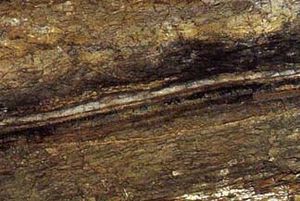
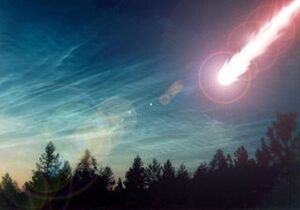
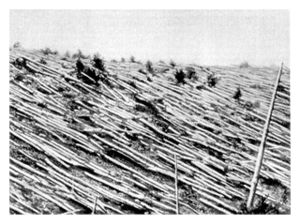
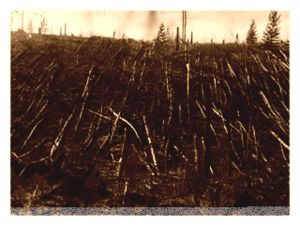
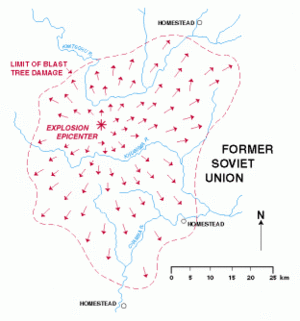
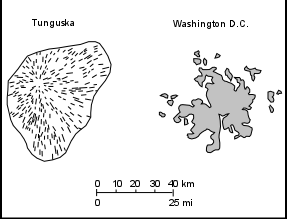
4 comments:
Very nice write up. Easy to understand and straight to the point.
Another great article. I like that you are very honest and direct to the point.
HI, Great Blog. I believe this blog post is one of the most informative thing. I will be waiting for your future posts.
what are you talking about the nonsense of Nibiru and Project Camelot? 1. What do u have against the web site Project Camelot? Are u uncomfortable with views and information that your belief system does not deem as valid? 2. Nonsense about Nibiru?? ibiru is the 4th dimensional flagship of the Milky Way Galaxy’s Galactic Federation. Like Pelegai, many different civilizations have representatives that live aboard it. As well as being a Federation Flagship, Nibiru is also a planet and a battle star. Nibiru is a little over three times the size of earth.
Nibiru was originally a planet that was thrown out of orbit with the implosion/explosion of Sirius B. It wound up in the Pleiades and therefore is known to some as a Pleiadian planet.
Nibiru became a star ship when it was converted from a near lifeless form, hollowed out and turned into a ship. You could liken it in some ways to the space station on the TV show called Deep Space Nine. The only difference is that Nibiru travels the galaxy. That is why the people live inside of it instead of on the surface. Another reason is that it was created for deep space travel where there would be no sun for many years. In a way, you could say that it is an artificial planet. Only the shell is original.Nibiru remains our trigger for awakening. Once it gets close enough to us, uncloaks and shows itself, it will bring about a universal shift in consciousness. Mankind will then wake up to the fact that they are not alone in the universe and will begin to search for the reason and purpose behind this great planet/ship. It is then that the ancient knowledge suppressed by the religions and governments of earth in order to control the people, will come to light. Mankind’s true identity will be made known to them and they will have the opportunity to embrace it on a global scale.
Nibiru’s effects are already being felt. Due to its massive size, Nibiru is already affecting our weather, our planetary frequency and our sun. Once again, I am not a scientist so I cannot give you this information in those terms. I will give you what they show me.
Nibiru is affecting our sun. Because of the pressure being exerted by its mass moving closer to us, it is creating pressure on the sun. This pressure is like squeezing a tomato until it begins to rupture. These ruptures are the solar flares and emissions from the sun. The sun is changing and emitting more light. Much like going from a 75 watt bulb to a 150 watt bulb. This changes our DNA and activates the dormant codes within it to begin the transmutation of our bodies from carbon-based to crystalline-based.
Post a Comment